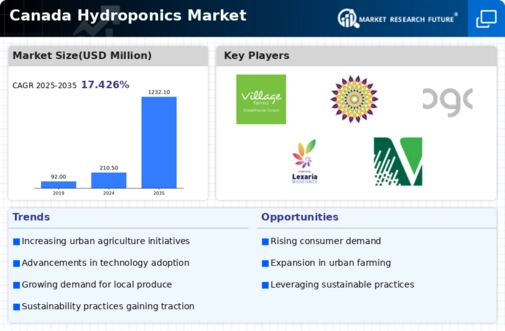Rising Demand for Fresh Produce
The hydroponics market in Canada experiences a notable increase in demand for fresh produce, driven by consumer preferences for locally sourced and organic food. This trend is particularly pronounced in urban areas, where access to fresh fruits and vegetables can be limited. As a result, hydroponic systems, which allow for year-round cultivation, are becoming increasingly popular among both commercial growers and home gardeners. The market for hydroponics in Canada is projected to grow at a CAGR of approximately 10% over the next five years, indicating a robust expansion in response to this demand. The hydroponics market is thus positioned to capitalize on the growing consumer inclination towards health-conscious eating habits, which further fuels the adoption of innovative growing techniques.
Government Support and Incentives
Government initiatives in Canada play a crucial role in fostering the growth of the hydroponics market. Various federal and provincial programs offer financial incentives, grants, and subsidies to encourage the adoption of sustainable agricultural practices, including hydroponics. These initiatives aim to enhance food security, promote local food production, and reduce the environmental impact of traditional farming methods. For instance, funding for research and development in hydroponic technologies has increased, leading to advancements that improve efficiency and yield. The hydroponics market benefits from this supportive regulatory environment, which not only stimulates investment but also encourages innovation among producers, thereby enhancing the overall competitiveness of the sector.
Urbanization and Space Constraints
Urbanization in Canada is contributing to the growth of the hydroponics market, as cities face increasing space constraints for traditional agriculture. Hydroponic systems, which require less land and can be implemented in vertical farms or greenhouses, offer a viable solution to urban food production challenges. This trend is particularly relevant in densely populated areas where land is at a premium. The hydroponics market is likely to benefit from the rising interest in urban agriculture, as more entrepreneurs and businesses explore hydroponic solutions to meet local food demands. The ability to produce food closer to consumers not only reduces transportation costs but also enhances the freshness of produce, aligning with consumer preferences for quality.
Environmental Sustainability Initiatives
The hydroponics market in Canada is increasingly influenced by environmental sustainability initiatives aimed at reducing the ecological footprint of agriculture. Hydroponic systems utilize significantly less water compared to traditional farming methods, making them an attractive option in regions facing water scarcity. Additionally, these systems can be designed to minimize land use and reduce pesticide application, aligning with the growing consumer demand for environmentally friendly products. The hydroponics market is likely to see a surge in interest from both consumers and investors who prioritize sustainability. As awareness of environmental issues continues to rise, hydroponics may emerge as a key player in the transition towards more sustainable food production practices in Canada.
Technological Integration in Agriculture
The integration of advanced technologies into the hydroponics market is transforming agricultural practices in Canada. Innovations such as automated nutrient delivery systems, climate control technologies, and data analytics are enhancing the efficiency and productivity of hydroponic farms. These technologies enable growers to optimize resource use, reduce waste, and improve crop yields. The hydroponics market is witnessing a shift towards smart farming solutions, which are expected to attract significant investment. As a result, the market is likely to see an increase in the number of high-tech hydroponic facilities, further driving growth. The potential for increased automation and precision agriculture could lead to a more sustainable and profitable hydroponics sector in Canada.
















Leave a Comment